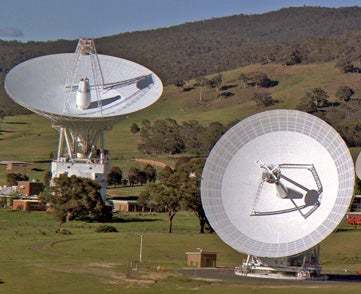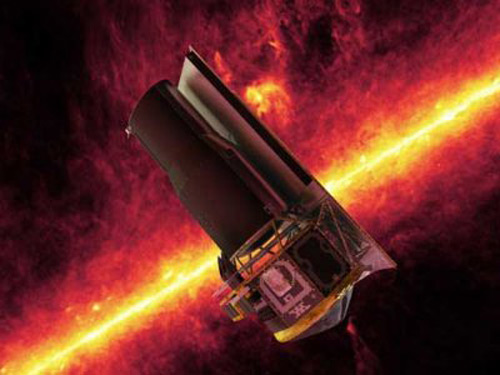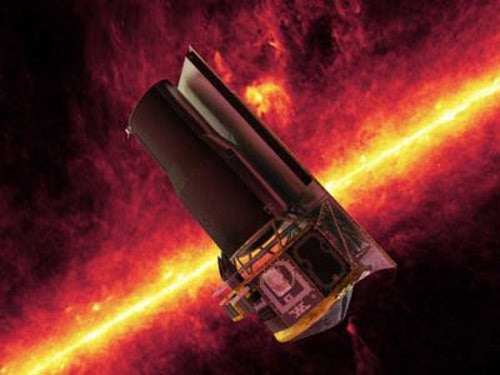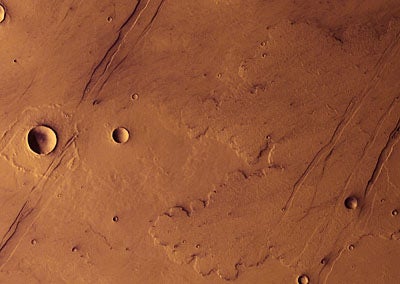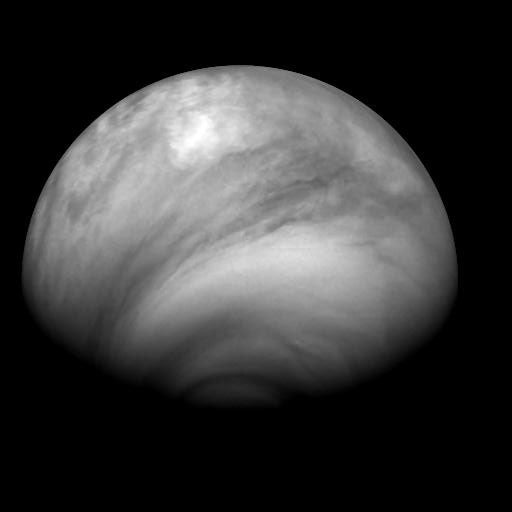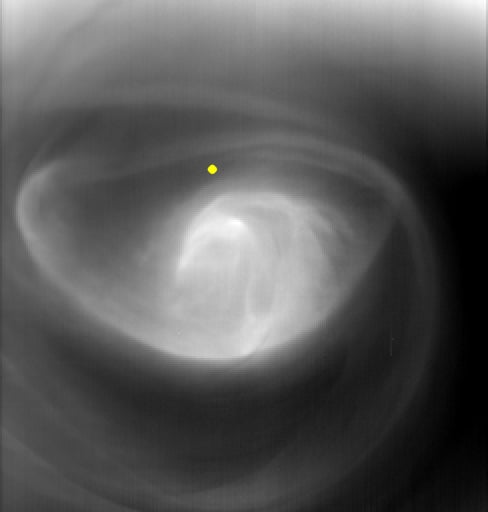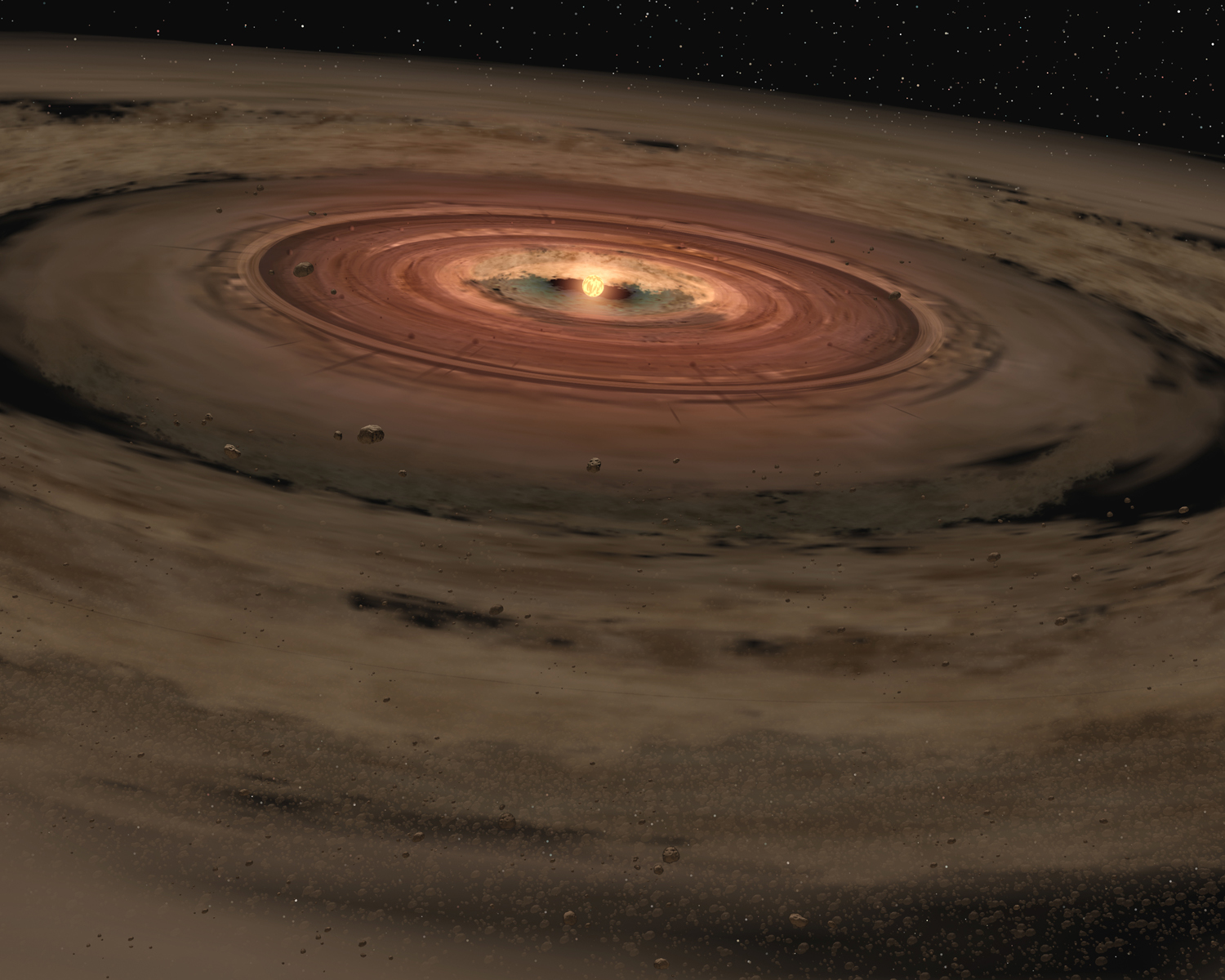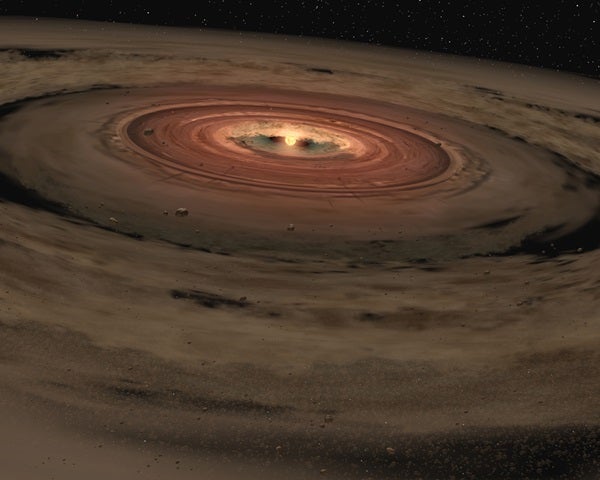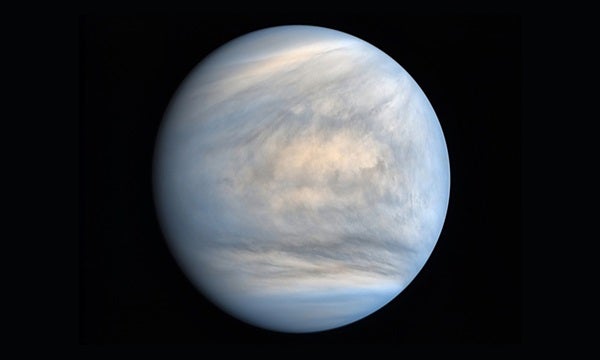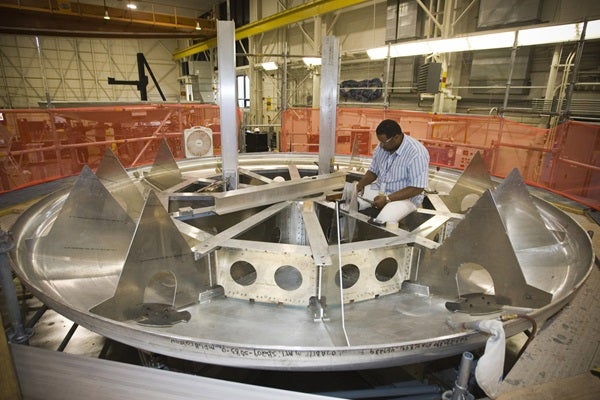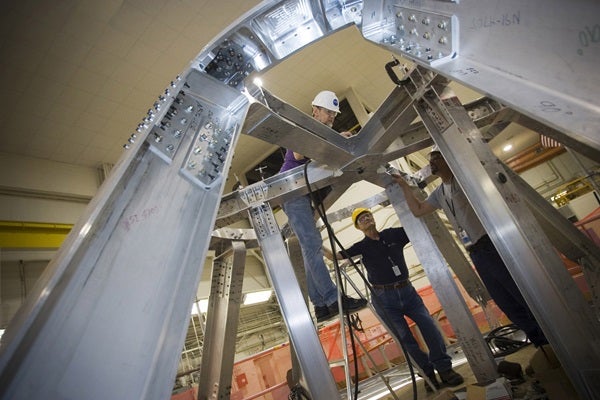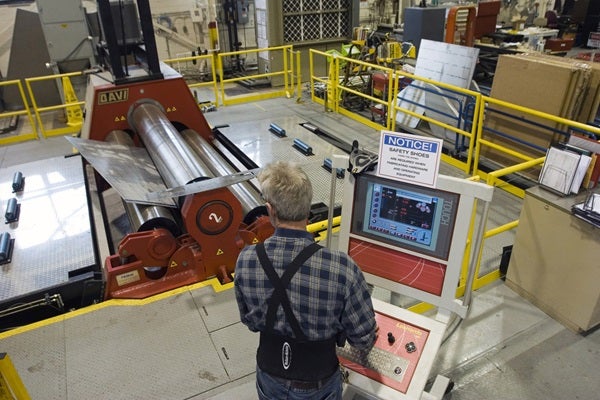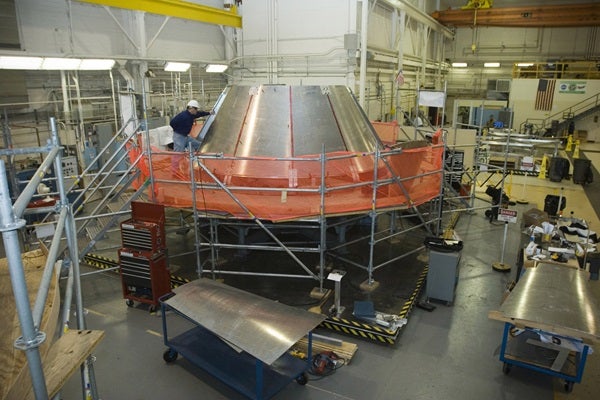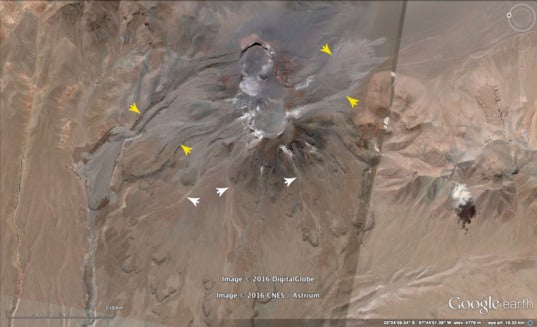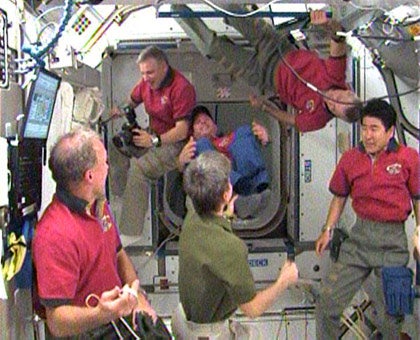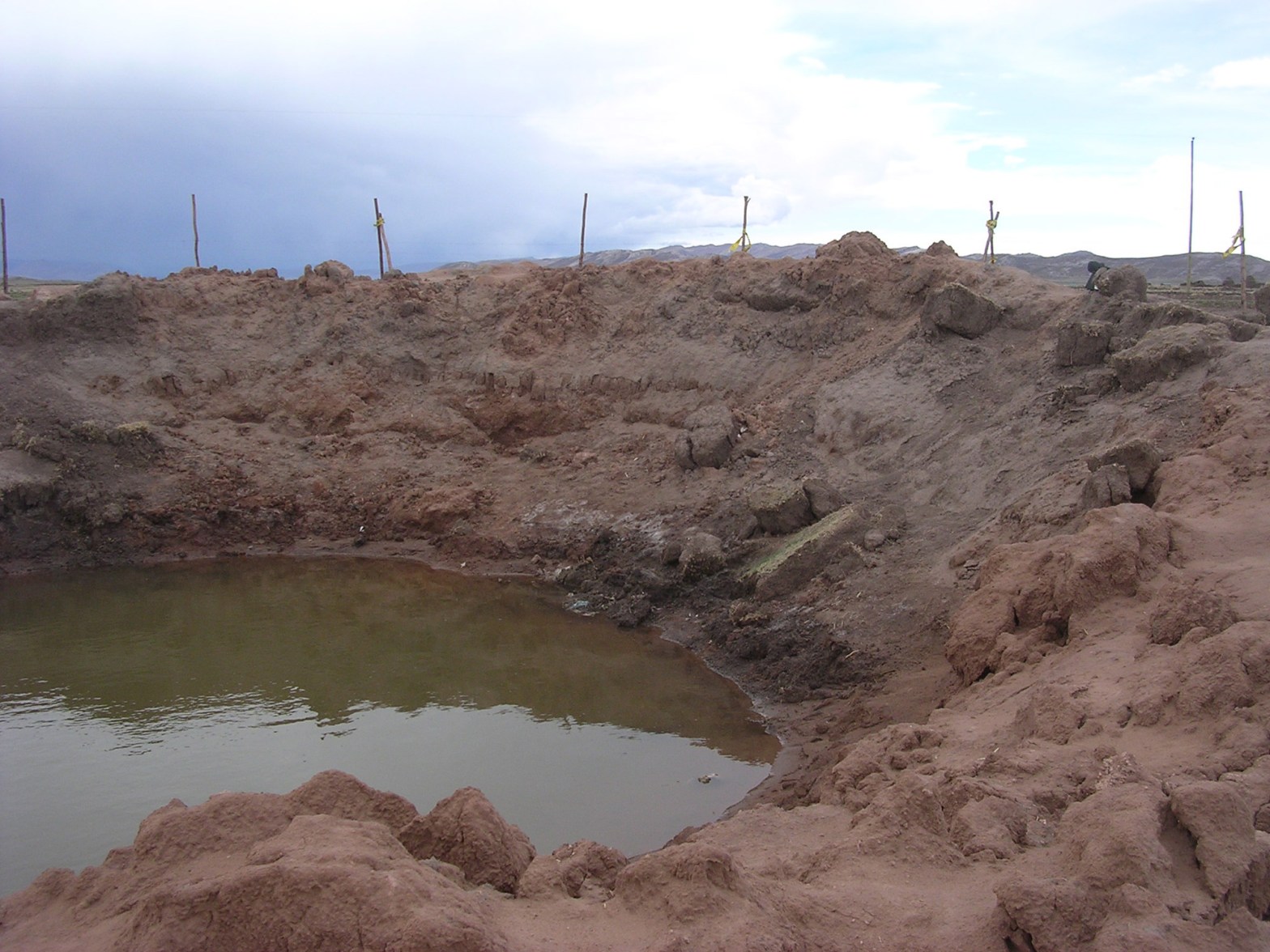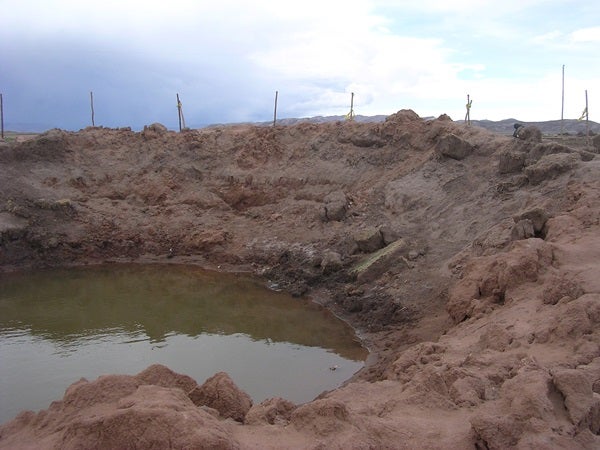The audio files below include excerpts of two interviews I did for the article. The first, with Deep Space Network Program Manager Michael Rodrigues, focuses on the role of NASA’s “big dishes.” The second, with Charles Scott, mission manager for NASA’s Spitzer Space Telescope, looks at communications from the perspective of an individual spacecraft.
View dark nebulae with your Meade scope
Astronomy magazine podcast: Saving historic observatories
In this week’s show, antique observatory advocate Trudy E. Bell surveys the plight of these historic landmarks.
For more information on the Antique Telescope Society and the workshop created to save them, click here.
After you listen, e-mail us here and let us know what you think.
If you would like to subscribe to our podcast, click here.
Water and planet formation
Water is an essential ingredient for forming planets, yet has remained hidden from scientists searching for it in protoplanetary systems, the spinning disks of particles surrounding newly formed stars where planets are born. Now the detection of water vapor in the inner part of two extrasolar protoplanetary disks brings scientists one step closer to understanding water’s role during terrestrial planet formation.
By maximizing the spectroscopic capabilities of NASA’s Spitzer Space Telescope and high-resolution measurements from the Keck II Telescope in Hawaii, researchers from the California Institute of Technology and other institutes found water molecules in disks of dust and gas around two young stars. DR Tau and AS 205A, respectively around 457 and 391 light-years away from Earth, are each at the center of a spinning disk of particles that may eventually coalesce to form planets.
“This is one of the very few times that water vapor has been detected in the inner part of a protoplanetary disk,the most likely place for terrestrial planets to form,” says Colette Salyk, a graduate student in geological and planetary sciences at Caltech. She is the lead author of a group of scientists reporting their findings in the March 20 issue of the Astrophysical Journal Letters.
Salyk and her colleagues first harnessed light-emission data captured by Spitzer to inspect dozens of young stars with protoplanetary disks. They honed in on DR Tau and AS 205A because these presented a large number of water emission lines, spikes of brightness at certain wavelengths that are a unique fingerprint for water vapor. “Only Spitzer is capable of observing these particular lines in a large number of disks because it operates above Earth’s obscuring water-vapor-rich atmosphere,” says Salyk.
To determine in what part of the disk the vapor resides, the team made high-resolution measurements at shorter wavelengths with NIRSPEC, the Near-InfraRed cross-dispersed echelle grating Spectrometer for the Keck II Telescope. Unlike Spitzer, which observed water lines blended together into clumps, NIRSPEC can resolve individual water lines in selected regions where the atmospheric transmission is good. The shape of each line relays information on the velocity of the molecules emitting the light. “They were moving at fast speeds,” says Salyk, “indicating that they came from close to the stars, which is where Earthlike planets might be forming.”
“While we don’t detect nearly as much water as exists in the oceans on Earth, we see only a very small part of the disk, essentially only its surface, so the implication is that the water is quite abundant,” remarks coauthor Geoffrey Blake, professor of cosmochemistry and planetary sciences and professor of chemistry at Caltech.
The presence of water in the inner disk may indicate its stage on the road to planet formation. A planet like Jupiter in our solar system grew as its gravitational field trapped icy solids spinning in the outer part of the sun’s planetary disk. However, before Jupiter gained much mass, these same icy solids could have traveled towards the star and evaporated to produce water vapor such as that seen around DR Tau and AS 205A.
Although they have not detected icy solids in the extrasolar disks, says Salyk, “our observations are possible evidence for the migration of solids in the disk. This is an important prediction of planet-forming models.”
These initial observations portend more to come, says coauthor Klaus Pontoppidan, a Caltech Hubble Postdoctoral Scholar in Planetary Science. “We were surprised at how easy it is to find water in planet-forming disks once we had learned where to look. It will take years of work to understand the details of what we see.”
Indeed, adds Blake, “This is a much larger story than just one or two disks. With upcoming observations of tens of young stars and disks with both Spitzer and NIRSPEC, along with our data in hand, we can construct a story for how water concentrations evolve in disks, and hopefully answer questions like how Earth acquired its oceans.”
Investigating the Red Planet’s volcanic past
A new analysis of impact cratering data from Mars reveals that the planet has undergone a series of global volcanic upheavals. These violent episodes spewed lava and water onto the surface, sculpting the landscape that ESA’s Mars Express looks down on today.
Using images from the High Resolution Stereo Camera (HRSC) on Mars Express, Gerhard Neukum, Freie Universität Berlin, Germany, and colleagues are discovering the history of the Red Planet’s geological activity. “We can now determine the ages of large regions and resurfacing events on the planet,” says Neukum. Resurfacing occurs when volcanic eruptions spread lava across the planet’s surface.
This work has suggested that the sculpting of the Martian surface has not proceeded in a steady fashion, as it does on Earth. Rather, the team have discovered that Mars has been wracked by violent volcanic activity five times in the past, after the early supposedly warmer and wetter phase, more than 3.8 thousand million years ago. In between these episodes, the planet has been relatively calm.
The five volcanic episodes stretch throughout Martian history, occurring around 3.5 thousand million years ago, 1.5 thousand million years ago, 400-800 million years ago, 200 million years ago and 100 million years ago. Neukum estimates that the dates of the earlier episodes are correct to within 100–200 million years and that the later dates are correct to within 20–30 million years.
The ages have been estimated by counting the number of small craters that appear on the landscape. The idea is simple: the older the surface, the more craters it will have accumulated as meteorites of all sizes have struck over the ages.
There has been a debate recently about the validity of this method.
Some researchers believe that the small craters are not produced by incoming meteorites but by chunks of Martian rock blasted over the surface after a single large impact. However American researchers, analysing seven years’ worth of images from the Mars Orbiter Camera
(MOC) on NASA’s Mars Global Surveyor, have found new craters appearing on the surface during that time.
“The present day cratering rate can be calculated from their observations,” says Neukum. It fits very closely with the cratering rate he established from the Mars Express data with Bill Hartmann, Planetary Science Institute, Tucson, Arizona, giving him confidence in the estimates.
During these volcanic episodes, eruptions of lava flowed across Mars.
The internal heat generated by the volcanic activity also caused water to erupt from the interior, causing wide-scale flash flooding.
As for why Mars behaves like this, geophysical computer-based models suggest that the planet has been trying to establish a system of plate tectonics, as there is on Earth where the crust is broken into slowly moving plates. On Mars, the volcanic episodes represent the planet almost achieving, but not actually attaining, plate tectonics – and these volcanic episodes might not be over.
“The interior of the planet is not cold yet, so this could happen again,” says Neukum.
Far from revealing a geologically dead world, Mars Express is exposing a place of subtle activity that could still erupt into something more spectacular.
A puzzling storm
Venus Express has constantly been observing the south pole of Venus and has found it to be surprisingly fickle. An enormous structure with a central part that looks like the eye of a hurricane, morphs and changes shape within a matter of days, leaving scientists puzzled.
The eye of the hurricane is at the center of a 2000 km-wide vortex. It was discovered in 1974 by the Mariner 10 spacecraft. There is a similar structure on the planet’s north pole, which was observed by the Pioneer Venus mission in 1979.
Venus Express scientists have been studying the structure in the thermal infrared, the wavelength range which reveals the temperature at the cloud-tops. Seen in this wavelength, the core of the vortex appears very bright, probably indicating that a lot of atmospheric gases are moving downward in the region, which creates a depression at the cloud-tops, making the region hotter.
“Simply put, the enormous vortex is similar to what you might see in your bathtub once you have pulled out the plug” says Giuseppe Piccioni, co-Principal Investigator for the Visible and Infrared Thermal Imaging Spectrometer (VIRTIS) on Venus Express, at IASF-INAF, Rome, Italy.
Scientists are not sure what actually creates the vortex. Colin Wilson, at the University of Oxford, says, “One explanation is that atmospheric gases heated by the Sun at the equator, rise and then move poleward. In the polar-regions, they converge and sink again. As the gases moves towards the poles, they are deflected sideways because of the planet’s rotation.”
The dynamic nature of this vortex is similar to behavior observed in other vortices on Earth, including those observed at the center of hurricanes.
A space garden?
Researchers using NASA’s Spitzer Space Telescope have discovered large amounts of simple organic gases and water vapor in a possible planet-forming region around an infant star, along with evidence that these molecules were created there. They’ve also found water in the same zone around two other young stars.
By pushing the telescope’s capabilities to a new level, astronomers now have a better view of the earliest stages of planetary formation, which may help shed light on the origins of our own solar system and the potential for life to develop in others.
John Carr of the Naval Research Laboratory, Washington, and Joan Najita of the National Optical Astronomy Observatory, Tucson, Arizona, developed a new technique using Spitzer’s infrared spectrograph to measure and analyze the chemical composition of the gases within protoplanetary disks. These are flattened disks of gas and dust that encircle young stars. Scientists believe they provide the building materials for planets and moons and eventually, over millions of years, evolve into orbiting planetary systems like our own.
“Most of the material within the disks is gas,” says Carr, “but until now it has been difficult to study the gas composition in the regions where planets should form.
Much more attention has been given to the solid dust particles, which are easier to observe.”
In their project, Carr and Najita took an in-depth look at the gases in the planet-forming region in the disk around the star AA Tauri. Less than a million years old, AA Tauri is a typical example of a young star with a protoplanetary disk.
With their new procedures, they were able to detect the minute spectral signatures for three simple organic molecules: hydrogen cyanide, acetylene and carbon dioxide, plus water vapor. In addition, they found more of these substances in the disk than are found in the dense interstellar gas called molecular clouds from which the disk originated.
“Molecular clouds provide the raw material from which the protoplanetary disks are created,” says Carr. “So this is evidence for an active organic chemistry going on within the disk, forming and enhancing these molecules.”
Spitzer’s infrared spectrograph detected these same organic gases in a protoplanetary disk once before. But the observation was dependent on the star’s disk being oriented in just the right way. Now researchers have a new method for studying the primordial mix of gases in the disks of hundreds of young star systems.
Astronomers will be able to fill an important gap. They know that water and organics are abundant in the interstellar medium but not what happens to them after they are incorporated into a disk. “Are these molecules destroyed, preserved or enhanced in the disk?” says Carr. “Now that we can identify these molecules and inventory them, we will have a better understanding of the origins and evolution of the basic building blocks of life, where they come from and how they evolve.” Carr and Najita’s research results appear in the March 14 issue of Science.
Taking advantage of Spitzer’s spectroscopic capabilities, another group of scientists looked for water molecules in the disks around young stars and found them, twice. “This is one of the very few times that water vapor has been directly shown to exist in the inner part of a protoplanetary disk, the most likely place for terrestrial planets to form,” says Colette Salyk, a graduate student in geological and planetary sciences at the California Institute of Technology in Pasadena. She is the lead author on a paper about the results in the March 20 issue of Astrophysical Journal Letters.
Salyk and her colleagues used Spitzer to look at dozens of young stars with protoplanetary disks and found water in many. They honed in on two stars and followed up the initial detection of water with complementary high-resolution measurements from the Keck II Telescope in Hawaii. “While we don’t detect nearly as much water as exists in the oceans on Earth, we see essentially only the disk’s surface, so the implication is that the water is quite abundant,” says Geoffrey Blake, professor of cosmochemistry and planetary sciences at Caltech and one of the paper’s coauthors.
“This is a much larger story than just one or two disks,” says Blake. “Spitzer can efficiently measure these water signatures in many objects, so this is just the beginning of what we will learn.”
“With upcoming Spitzer observations and data in hand,” Carr adds, “we will develop a good understanding of the distribution and abundance of water and organics in planet- forming disks.”
Cassini’s daring flyby of Enceladus
NASA’s Cassini spacecraft performed a daring flyby of Saturn’s moon Enceladus March 12, flying about 32,000 mph (15 kilometers per second) through icy water geyser-like jets. The spacecraft snatched up precious samples that might point to a water ocean or organics inside the little moon.
Scientists believe the geysers could provide evidence that liquid water is trapped under the icy crust of Enceladus. The geysers emanate from fractures running along the moon’s south pole, spewing out water vapor at approximately 800 mph (400 meters per second).
The new data provide a much more detailed look at the fractures that modify the surface and will give a significantly improved comparison between the geologic history of the moon’s north pole and south pole.
New images show that compared to much of the southern hemisphere on Enceladus, the south polar region in particular, the north polar region is much older and pitted with craters of various sizes. These craters are captured at different stages of disruption and alteration by tectonic activity, and probably from past heating from below. Many of the craters seem sliced by small parallel cracks that appear to be ubiquitous throughout the old cratered terrains on Enceladus.
“These new images are showing us in great detail how the moon’s north pole differs from the south, an important comparison for working out the moon’s obviously complex geological history,” says Carolyn Porco, Cassini imaging team leader, Space Science Institute, Boulder, Coloado “And the success of yesterday’s daring and very low-altitude flyby means this coming summer’s very close encounter, when we get exquisitely detailed images of the surface sources of Enceladus’ south polar jets, should be an exciting next big step in understanding just how the jets are powered.”
This week’s flyby and another one planned for October 9, 2008, were designed so that Cassini’s particle analyzers could dissect the body of the plume for information on the density, size, composition and speed of the particles. Among other things, scientists will use the data gathered this week to figure out whether the gases from the plume match the gases that make up the halo of particles around Enceladus.
This may help determine how the plumes formed.
During Cassini’s closest approach, two instruments were collecting data: the Cosmic Dust Analyzer and the Ion and Neutral Mass Spectrometer. An unexplained software hiccup with Cassini’s Cosmic Dust Analyzer instrument prevented it from collecting any data during closest approach, although the instrument did get data before and after the approach. During the flyby, the instrument was switching between two versions of software programs. The new version was designed to increase the ability to count particle hits by several hundred hits per second. The other four fields and particles instruments on the spacecraft, in addition to the ion and neutral mass spectrometer, did capture all of their data, which will complement the overall composition studies and elucidate the unique plume environment of Enceladus.
Cassini’s instruments discovered evidence for the geyser-like jets on Enceladus in 2005, finding that the continuous eruptions of ice water create a gigantic halo of ice dust and gas around Enceladus, which helps supply material to Saturn’s E-ring.
This was the first of four Cassini flybys of Enceladus this year. During Wednesday’s flyby, the spacecraft came within 30 miles (50 kilometers) of the surface at closest approach, 120 miles (200 kilometers) while flying through the plume. Future trips may bring Cassini even closer to the surface of Enceladus. Cassini will complete its prime mission, a 4-year tour of Saturn, in June. From then on, a proposed extended mission would include seven more Enceladus flybys. The next Enceladus flyby would take place in August of this year.
Life soup
The organic soup that spawned life on Earth may have gotten generous helpings from outer space, according to a new study. Scientists at the Carnegie Institution have discovered concentrations of amino acids in two meteorites that are more than ten times higher than levels previously measured in other similar meteorites. This result suggests that the early solar system was far richer in the organic building blocks of life than scientists had thought, and that fallout from space may have spiked Earth’s primordial broth.
Amino acids are organic molecules that form the backbone of proteins, which in turn build many of the structures and drive many of the chemical reactions inside living cells. The production of proteins is believed to constitute one of the first steps in the emergence of life. Scientists have determined that amino acids could also have formed in some environments on the early Earth, but the presence of these compounds in certain meteorites has led many researchers to look to space as a source.
The study, by Marilyn Fogel of Carnegie’s Geophysical Laboratory and Conel Alexander of the Department of Terrestrial Magnetism with Zita Martins of Imperial College London and two colleagues, will be published in Meteoritics and Planetary Science.
The meteorites used for the study were collected in Antarctica in 1992 and 1995 and held in the meteorite collection at the NASA Johnson Space Center in Houston, Texas. Antarctica is the world’s richest hunting ground for meteorites, which are naturally concentrated in so-called blue ice regions and held in cold storage by the ice.
For the amino acid study, the researchers took small samples from three meteorites of a rare type called CR chondrites, thought to contain the oldest and the most primitive organic materials found in meteorites. CR chondrites date from the time of the solar system’s formation. During an early phase of their history the meteorites were part of a larger “parent body,” such as an asteroid, which later was shattered by impacts.
The analysis revealed that while one sample showed a relatively low abundance of amino acids, the other two meteorites had the highest ever seen in primitive meteorites-180 and 249 ppm (parts per million). Other primitive meteorites that have been studied generally have amino acid concentrations of 15 ppm or less. Because organic molecules from extra-terrestrial sources have ratios of carbon isotopes different from those of Earthly biological sources, the researchers were able to rule out contamination as a factor in their result.
“The amino acids probably formed within the parent body before it broke up,” says Alexander. “For instance. ammonia and other chemical precursors from the solar nebula, or even the interstellar medium, could have combined in the presence of water to make the amino acids. Then, after the break up, some of the fragments could have showered down onto the Earth and the other terrestrial planets. These same precursors are likely to have been present in other primitive bodies, such as comets, that were also raining material onto the early Earth.”
New spacecraft for NASA
Returning humans to the Moon by 2020 may seem like a distant goal, but NASA’s Constellation Program already has scheduled the first test flight toward that goal to take place in less than 12 months.
The Constellation Program is developing a new space transportation system to travel beyond low Earth orbit, expanding human exploration of the solar system and extending human reach to the moon and Mars.
The 90-second flight will not leave Earth’s atmosphere, but it will be an important first step toward demonstrating how NASA intends to build safety into its next generation of spacecraft, including the Ares I and V rockets and the Orion crew capsule.
The first in a series of unmanned abort tests, known as Pad Abort-1 or PA-1, is scheduled for late 2008 at the U.S. Army’s White Sands Missile Range in New Mexico.
Orion is the Constellation Program’s new crew exploration vehicle, set to carry as many as four crew members to lunar orbit and return its crew safely to Earth after missions to the moon’s surface. The 16.5-foot (5-meter) wide, cone-shaped capsule also will provide transport services to the International Space Station for as many as six crewmembers.
But before launching to the Moon or to the International Space Station, system tests on Earth have to prove the technologies work.
The pad abort test will simulate an emergency on the launch pad. Upon command from a nearby control center, a dummy Orion crew module, which would sit on top of a rocket for an actual launch, will be ejected directly from the launch pad by its rocket-propelled launch abort system to about one mile in altitude and nearly one mile downrange.
Engineers and technicians at Langley designed and fabricated the structural shell of the simulated crew module for the first pad abort test and now are conducting a series of ground checks on the structure. The crew module simulator, as it is called, accurately replicates the size, outer shape and mass characteristics of the Orion crew module.
“The next step is to ship the completed crew module simulator to Dryden, where they will outfit it with the smarts, the computers, the electronics, the instrumentation, all the systems that need to work in conjunction with the structure,” says Phil Brown, manager of the Langley Orion Flight Test Article Project.
During the pad abort test sequence, the escape system’s main abort motor will fire for several seconds, rapidly lifting the simulated crew module from the test launch pad, after which the escape system will detach, and three 116-foot-diameter parachutes will deploy to slow the module for landing.
The test will provide early data for design reviews to follow and will be followed by an ascent abort test in 2009 and a second pad abort test scheduled for 2010, both at White Sands. A parallel series of higher-altitude launch tests will commence at NASA’s Kennedy Space Center in Florida in 2009.
In addition to Langley, Dryden and Kennedy, the Orion Project launch abort system team and the abort flight test team includes members from NASA’s Marshall Space Flight Center in Huntsville, Alabama, NASA’s Johnson Space Center in Houston and NASA’s Glenn Research Center near Cleveland, as well as Orion Project prime contractor, Lockheed Martin of Denver; and its subcontractor, Orbital Sciences Inc. of Dulles, Virginia.
One day down, 11 more to go
The crews of space shuttle Endeavour and the International Space Station have completed their first day as an orbital team, beginning 12 days of joint operations.
About an hour before docking, which occurred at 11:49 p.m. EDT Wednesday, STS-123 Commander Dominic Gorie guided the shuttle through a back-flip maneuver, giving the Expedition 16 crew the opportunity to take pictures of the orbiter’s protective heat-resistant tiles. These photos were sent to engineers on Earth for analysis.
The STS-123 and Expedition 16 crews opened the hatches between Endeavour and the station at 1:36 a.m. The crews then spent time preparing for the first of five scheduled STS-123 spacewalks, which Mission Specialist Rick Linnehan and Expedition 16 Flight Engineer Garrett Reisman will begin at 9:23 p.m. Thursday.
Shortly after Endeavour’s arrival at the station, Reisman traded places with Flight Engineer Léopold Eyharts, a European Space Agency astronaut, to join the Expedition 16 crew. Eyharts will return to Earth aboard Endeavour.
In addition, the STS-123 crew will install the Canadian-built Dextre, the final element of the station’s Mobile Servicing System, and the Japanese Logistics Module Pressurized Section, which is the first component of the Japan Aerospace Exploration Agency’s Kibo laboratory.
A Peruvian mystery
Nothing appeared odd about all this — until scientists examined the scene in detail. Two groups reported on their investigations Tuesday at the 39th Lunar and Planetary Science Conference in Houston. Peter Schultz of Brown University and Thomas Kenkmann of the Museum für Naturkunde, Mineralogie, at Humboldt-Universität Berlin, described their team’s startling findings. “This just isn’t what we expected,” says Schultz. “It was to the point that many thought this was fake.”
The surprise arose when the researchers realized the impacting body was a stony meteorite, a fragile type scientists thought would get ripped to pieces as it tore through Earth’s atmosphere. Obviously, that didn’t happen. The atmosphere typically slows such a meteorite way down, and it leaves a small pit — not a crater — when it hits the ground. “But this meteorite kept on going at a speed 40 to 50 times faster than it should have been going,” or about 15,000 mph (24,000 km/h), says Schultz.
Schultz thinks the object survived because it was moving so fast. The fragments of the disintegrating meteorite couldn’t escape the fireball’s shock wave, and reformed into a more aerodynamic shape. Like a football spiraling through the air, the incoming meteorite easily penetrated the atmosphere.
If Schultz is right, many craters created by stony-meteorite impacts could exist. Unfortunately, weathering would render them unrecognizable within a short period. Already, the Carancas crater is losing many of the characteristics that make it an obvious impact site. “You just wonder how many other lakes and ponds were created by stony meteorites,” says Schultz.


